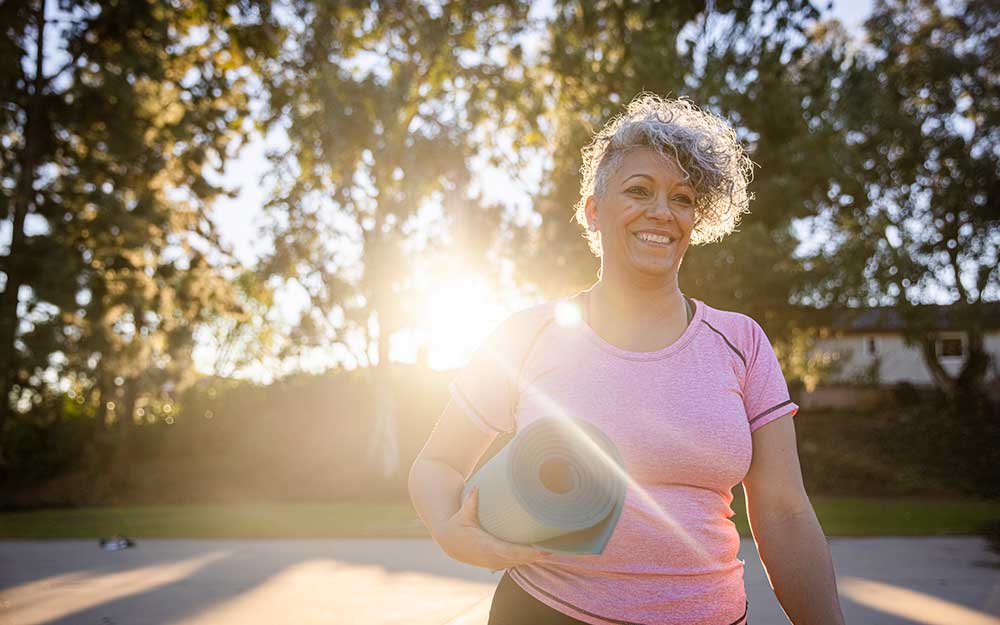Find Your Fitness Tracker Sweet Spot
Date
March 23, 2022
Credits
Date
March 23, 2022
Credits
Medical providers featured in this article
In Brief
{{cta-block}}
If you've ever used a fitness tracker, you know it can be both cheerleader and taskmaster. On good days, it motivates you to reach your health goals. On bad days—when you can't keep that coveted running pace or some decadent dessert pushes you past your calorie count—it glaringly reminds you of your shortcomings.
Your fitness tracker can even rob you of the joy you once felt while walking, eating or slumbering, replacing it with concerns about step counts, calories and sleep quality.
So why use it? Because it can help you tune into personal habits along with vital messages your body may be sending you.
"If you hit these aerobic goals, you significantly decrease your risk for chronic conditions such as hypertension, cardiovascular disease and even diabetes."
"We already have natural sensors throughout our bodies, but we don't always pay attention to them," says Dr. Brennan Spiegel, director of Cedars-Sinai's Health Services Research, whose medical research includes the use of wearable biosensors and consumer fitness trackers. "We might eat, for example, not because we're hungry, but because there's food in front of us. We ignore our body's signals that tell us we don't need to eat."
{{providers}}
Fitness trackers take those signals and present the data in a way that nabs our attention, he says, enabling us to compare our progress against our set goals.
According to a 2021 report by the IQVIA Institute for Human Data Science, activity trackers account for more than half of the 384 available consumer wearable devices. Fitness apps comprise a quarter of the more than 350,000 available health apps.
But these devices and apps are just tools, says Dr. Spiegel. Using the data they collect requires some guidance and wisdom. The following tips will help you get the most out of your fitness apps and devices.
Magazine: More than Weight Loss: Patient and Doctor Team Up for Wellness Success
Name your goal
Decide what you want to achieve. Is your goal to lose weight, improve sleep quality, boost your cardio, lower blood pressure or prevent chronic disease? Find and use a tracker that measures metrics that support your goal.
"It all starts with picking the problem and becoming mentally prepared to engage in a health activity to address it," Dr. Spiegel says.
Work with a program
Join and follow a program to get the information and support you need to stay motivated and on target with your goals. This might be a personalized plan created with your healthcare provider or a commercial program.
"For example, a tracker alone won't help you lose weight. But when used as part of a larger program—where you count calories, change your diet and keep track of activity—you're more likely to drop the pounds," Dr. Spiegel says.
Track what matters

A 2021 survey of 2,009 Americans ages 14-75 revealed that their top five tracked fitness metrics were step counts, workouts, heart rate, calories consumed and sleep quality.
Which data matter most for you will depend on your goals, but following the American Heart Association's recommendations for aerobic activity is a good place to start, says Cedars-Sinai primary care physician Dr. Matthew Kollefrath. These include a weekly output of at least 150 minutes of moderate exercise (for example, brisk walking) or 75 minutes of vigorous aerobic activity (running, swimming laps).
"If you hit these aerobic goals, you significantly decrease your risk for chronic conditions such as hypertension, cardiovascular disease and even diabetes," Dr. Kollefrath says.
Listen to your body
Be cautious when following any fitness advice your tracker offers. Running apps, for example, provide tips on form and cadence, yet these may not be appropriate for you.
"If you blindly follow guidance on your tracker, you could injure yourself," says Dr. Spiegel, a marathon runner who experimented with bumping his cadence up from 170 steps to a tracker's recommended 178-182 steps per minute. The increase almost damaged the connective tissue in his right foot.
Be willing to experiment, but pay attention to your body, he says, especially any pain that might indicate a problem.
Avoid obsession
Constantly checking your heart rate or obsessing over daily step counts can lead to health anxiety. Viewing your data from a long-term perspective, however, helps you to notice trends along with any positive or negative results from your activity.
"It's important to remember that gradual changes are what help you form healthy lifestyle habits and prevent you becoming discouraged by an off day," Dr. Kollefrath says.
Share with your doctor
Sharing your data with your doctor can be a great way to start conversations about how to prevent or manage chronic conditions and meet your personal health goals.
"There are no medical decisions to be made off the raw data, but it can be helpful when compared with desired outcomes," Dr. Kollefrath says. "By relating it with trends over time, I can show a patient, 'Look, when you're hitting these goals your blood pressure or your cholesterol comes down' or 'When you exercise this much, we see a good rate of weight loss.'"
Cedars-Sinai patients can use the My CS-Link app to share their fitness tracker data with their doctor. Working together with their physician, they can develop plans to adjust their lifestyle to promote optimal health.






